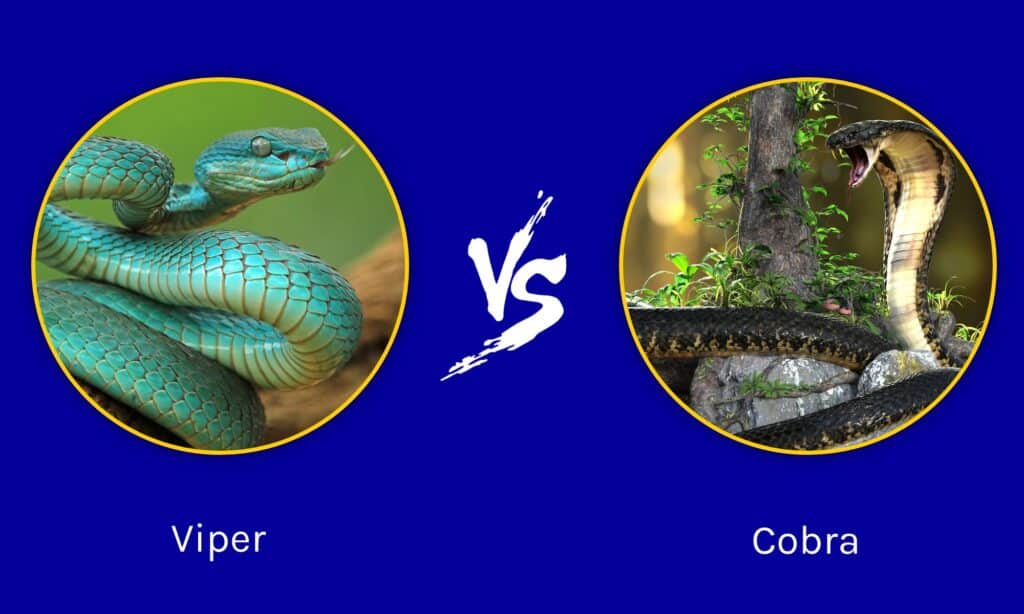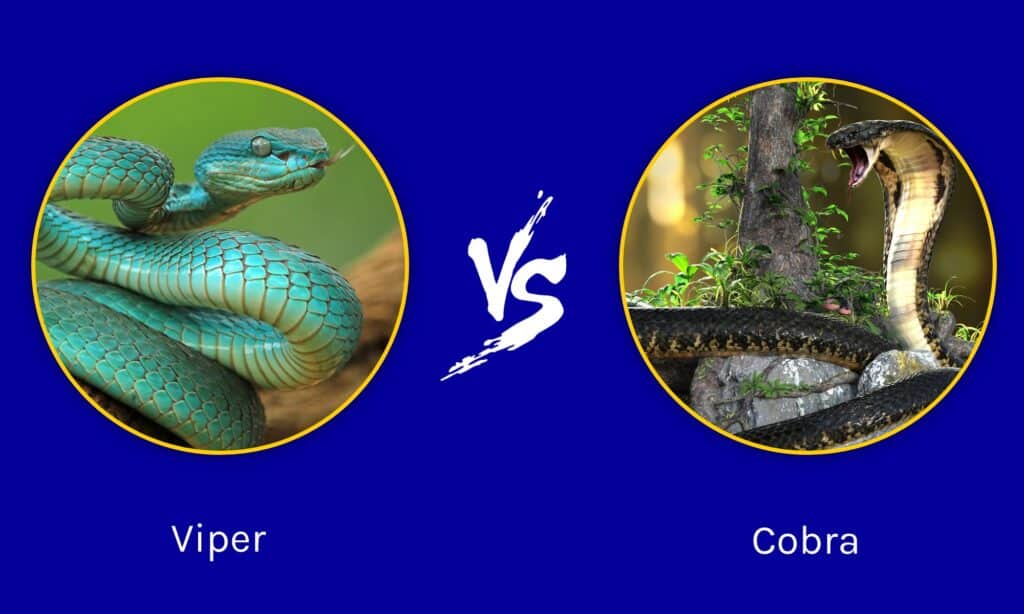When it comes to venomous snakes, the viper stands out among the rest. With its distinctive triangular-shaped head and long, hollow fangs, it’s no wonder the viper is often associated with danger and fear. But how does the viper compare to other venomous snakes in terms of its characteristics and behavior?
In this article, we will delve into the world of venomous snakes and explore the unique traits that distinguish the viper from its counterparts. From their hunting techniques to the composition of their venom, we will examine what makes the viper a formidable predator and how it stacks up against other venomous snakes. So, buckle up and get ready to learn more about these fascinating and deadly creatures!
Vipers are a type of venomous snake known for their long, hollow fangs that fold against the roof of their mouth when not in use. They are also known for their triangular-shaped head and vertical pupils. Compared to other venomous snakes, vipers are generally more aggressive and have a higher venom yield. They can also strike from a greater distance and have a faster strike speed.

Viper Vs. Other Venomous Snakes: A Comparison of Their Characteristics and Behavior
Venomous snakes are fascinating creatures that have evolved over millions of years to become some of the most efficient predators in the animal kingdom. Vipers and other venomous snakes are particularly interesting due to their unique characteristics and behavior. In this article, we will explore the differences between vipers and other venomous snakes, including their physical traits, hunting strategies, and venom types.
Viper Characteristics
Vipers are a family of venomous snakes that are known for their distinctive triangular heads, hinged fangs, and heat-sensing pits located between their eyes and nostrils. They are found all over the world, but most commonly in Asia, Africa, and Europe. Vipers are ambush predators that rely on their camouflage and patience to catch their prey, which includes small mammals, birds, and other reptiles.
Vipers have long, curved fangs that fold back against the roof of their mouth when not in use. When they strike, the fangs swing forward and inject venom into their prey. Vipers produce a variety of venom types, including hemotoxic, neurotoxic, and cytotoxic. Hemotoxic venom attacks the circulatory system and can cause internal bleeding, while neurotoxic venom affects the nervous system and can lead to paralysis. Cytotoxic venom destroys cells and tissue, causing pain, swelling, and necrosis.
Other Venomous Snakes Characteristics
There are many other types of venomous snakes besides vipers, including cobras, kraits, and coral snakes. These snakes have different physical characteristics and hunting strategies than vipers. Cobras, for example, have a distinctive hood that they flare out when threatened, while kraits are known for their potent neurotoxic venom. Coral snakes, on the other hand, have brightly colored bands that warn predators of their venomous nature.
Unlike vipers, many other venomous snakes are active hunters that actively seek out their prey. Cobras, for example, hunt rodents and other small mammals by stalking them and delivering a deadly bite. Kraits hunt lizards and other snakes by sneaking up on them and injecting them with venom. Coral snakes hunt small reptiles and amphibians by burrowing into the ground and waiting for their prey to pass by.
Viper Vs. Other Venomous Snakes: Physical Differences
In terms of physical characteristics, vipers have a number of unique features that distinguish them from other venomous snakes. As mentioned earlier, vipers have triangular heads, hinged fangs, and heat-sensing pits. They also have keeled scales, which give them a rough, textured appearance. Many other venomous snakes, on the other hand, have smooth scales and round heads.
Another physical difference between vipers and other venomous snakes is their body shape. Vipers have a stocky, muscular body with a short tail, while many other venomous snakes have a more slender, elongated body with a longer tail. This body shape allows vipers to strike quickly and powerfully, while other venomous snakes rely more on speed and agility to catch their prey.
Viper Vs. Other Venomous Snakes: Venom Types
One of the most important differences between vipers and other venomous snakes is the type of venom they produce. Vipers produce a variety of venom types, including hemotoxic, neurotoxic, and cytotoxic. This venom is designed to immobilize and kill their prey quickly and efficiently. Other venomous snakes, such as cobras and kraits, produce predominantly neurotoxic venom, which affects the nervous system and can lead to paralysis.
The type of venom produced by a snake can also affect how it is treated if it bites a human. Hemotoxic venom, for example, can cause severe tissue damage and may require surgery to repair. Neurotoxic venom, on the other hand, can cause respiratory failure and may require respiratory support. Knowing the type of venom produced by a snake is critical for providing the appropriate medical treatment.
Viper Vs. Other Venomous Snakes: Hunting Strategies
Finally, vipers and other venomous snakes have different hunting strategies that are adapted to their unique physical characteristics and venom types. Vipers are ambush predators that rely on their camouflage and patience to catch their prey. They will often lie in wait for hours or even days until a suitable prey item comes along. Once they strike, they deliver a powerful bite that injects venom into their prey.
Other venomous snakes, such as cobras and kraits, are active hunters that actively seek out their prey. They will stalk their prey and deliver a quick, deadly bite. Coral snakes, on the other hand, burrow into the ground and wait for their prey to pass by. Once they detect a suitable prey item, they will strike and inject venom.
Benefits of Viper and Other Venomous Snakes
Although vipers and other venomous snakes can be dangerous to humans, they also play an important role in their respective ecosystems. As top predators, they help to control populations of rodents and other small mammals. In addition, their venom has been used to create lifesaving medications, such as antivenom and painkillers.
Viper Vs. Other Venomous Snakes: Conclusion
In conclusion, vipers and other venomous snakes are fascinating creatures that have evolved unique characteristics and hunting strategies. Vipers are ambush predators that rely on their camouflage and patience to catch their prey, while other venomous snakes are active hunters that actively seek out their prey. Vipers produce a variety of venom types, while other venomous snakes produce predominantly neurotoxic venom. Understanding the differences between vipers and other venomous snakes is important for appreciating the diversity of the animal kingdom and for providing appropriate medical treatment in case of a snake bite.
Frequently Asked Questions
In this section, we have answered some of the frequently asked questions about the characteristics and behavior of venomous snakes, including vipers.
What are the characteristics of venomous snakes?
Venomous snakes are characterized by their venom glands, which are located behind their eyes and connected to their fangs. These snakes use venom to immobilize their prey or defend themselves from predators. Venomous snakes also have triangular-shaped heads, slit-like pupils, and heat-sensing pits on their faces, which helps them to detect prey and track their movements.
Some of the most common venomous snakes include vipers, cobras, rattlesnakes, and coral snakes. Each of these snakes has its unique set of characteristics and behaviors that differentiate them from other species.
How do vipers behave compared to other venomous snakes?
Unlike some other venomous snakes, vipers are known for their aggressive behavior and tendency to strike without warning. Vipers are also excellent hunters and can strike their prey with incredible accuracy, thanks to their heat-sensing pits and sharp fangs.
Another characteristic that sets vipers apart from other venomous snakes is their ability to retract their fangs. Unlike cobras and other venomous snakes, vipers can retract their fangs when they’re not in use, which helps protect them from accidental injury.
What is the most venomous snake in the world?
The most venomous snake in the world is the inland taipan, also known as the “fierce snake.” This species of snake is native to Australia and has the most potent venom of any snake species. Fortunately, the inland taipan is not aggressive towards humans and is rarely encountered in the wild.
Other highly venomous snakes include the black mamba, king cobra, and the coastal taipan. Each of these snakes has its unique set of characteristics and behaviors that make them dangerous to humans.
What should I do if I encounter a venomous snake?
If you encounter a venomous snake, the best thing to do is to stay calm and move away slowly. Do not try to handle or capture the snake, as this can provoke it and increase the risk of a bite.
If you are bitten by a venomous snake, seek medical attention immediately. Symptoms of a snakebite can vary depending on the species of snake and the amount of venom injected, but can include pain, swelling, and difficulty breathing.
How can I prevent snake bites?
To prevent snake bites, it’s essential to be aware of your surroundings and avoid areas where venomous snakes are known to live. Wear long pants and sturdy shoes when hiking or working in areas where snakes are likely to be present. If you’re camping, keep your tent zipped up, and do not leave food or garbage lying around, as this can attract snakes and other wildlife.
If you live in an area where venomous snakes are common, consider installing snake-proof fencing around your property and be vigilant when working or playing outdoors.
In conclusion, the comparison between viper and other venomous snakes highlights the unique characteristics and behavior of each species. While vipers are known for their large fangs and potent venom, other venomous snakes such as coral snakes use their bright colors to warn predators of their toxicity.
Despite their differences, all venomous snakes play a crucial role in their respective ecosystems. They help control the population of prey animals and serve as a reminder of the importance of respecting nature.
Overall, learning about the characteristics and behavior of venomous snakes can help us better understand and appreciate these fascinating creatures. By respecting their role in the ecosystem and taking necessary precautions when interacting with them, we can coexist with these animals in a safe and mutually beneficial way.


